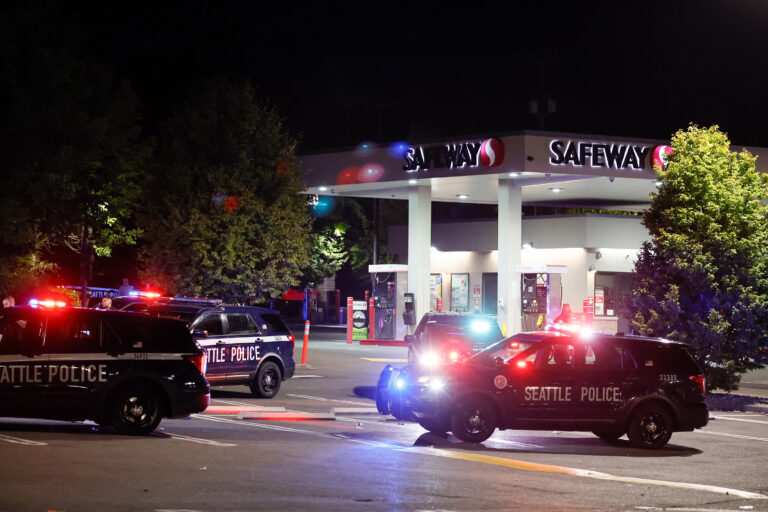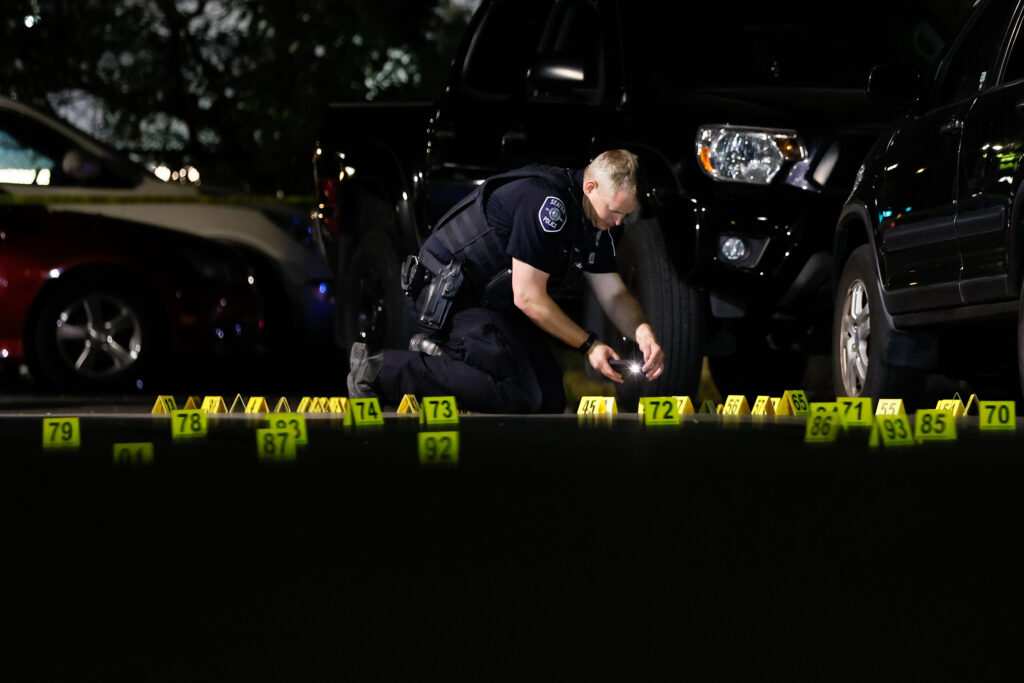
Two young men, both in their 20s, arrived at Seattle’s Harborview Medical Center with gunshot wounds within minutes of one another on a recent afternoon.
They reportedly shot each other in Rainier Vista, one suffering a pair of wounds to his abdomen, the other a femoral bleed to his left thigh.
Both survived, but they could have easily been added to the tally of Seattle’s near-record number of 2023 homicide victims, casualties of the deadly gun violence that’s continued to grip the city even as other violent crime dropped 7% from last year, according to police Chief Adrian Diaz.

Homicides, he said, remain stubbornly high.
Sixty-eight people have been killed in Seattle homicides this year, accounting for nearly half of the 138 killings committed across King County as of Thursday, according to preliminary data compiled by The Seattle Times. That’s the most ever in a single year, far eclipsing the 119 homicides committed countywide in both 2021 and 2022. More than three-quarters of victims died from gunshot wounds.
“I’m just assuming everybody is armed all the time now,” said John Castleton, who with Mary Barbosa leads a team of senior deputy prosecutors who respond to homicide scenes in the county. “It’s a sad way to live, but that’s kind of the reality we’re in.”
Violent crime began rising nationwide with the onset of the COVID-19 pandemic and accelerated even more in 2021 before beginning to level off by the end of last year. Going into 2023, there was hope local homicide figures would drop to pre-pandemic figures — but that didn’t happen.
“National trends have been leveling out, and I think we were certainly hoping that we would follow that, but we haven’t yet,” Barbosa said. “I think I’m going into 2024 less optimistic than I started 2023.”
“We’re still on the upswing,” Castleton added, “and we’re befuddled as to why.”
No single underlying reason explains the increase. This year’s homicides span the gamut, with drugs, gangs, road rage, domestic violence and homelessness contributing to the county’s tally. Shootouts involving multiple guns have also become much more frequent.
But two factors weigh heavily in the Seattle area’s favor.
Barbosa and Castleton agree that if not for the county’s Medic One units, which administer blood to trauma patients en route to the hospital, and the existence of Harborview, a regional trauma center in the heart of Seattle, the county’s homicide figures would be much, much higher.
“Between Medic One and Harborview, our kind of thinking is that if [patients] can get to Harborview with a pulse, we’re pretty confident they’re going to survive,” Castleton said. “I don’t think you can say that about a lot of other places.”
Even so, victims of shootings and other violent assaults often suffer catastrophic, life-changing injuries and frequently die from complications weeks, months or years after their initial injury, said Barbosa.
That’s one reason homicide counts can vary, depending on which victims are counted in a given year. Seattle police, for example, have put this year’s count at 72, a number that includes the discovery of a human skull in Rainier Beach, the death of an unborn baby who died after a pregnant woman was fatally shot in Belltown, and the delayed deaths of two men, one who was shot in 2021 and a second who was stabbed last year.
Four men were also fatally shot this year in confrontations with police: two in Kent and one each in Federal Way and Bellevue. Though still considered homicides, such killings are typically not included in the county’s total.
Keeping victims off ‘the homicide list’
Seattle saw a record 69 homicides in 1969 — a figure that would go unmatched for 25 years, until 1994, when gang conflicts over crack cocaine sales reached their zenith, according to Seattle Times’ archives.
In 1970, the Seattle Fire Department launched its Medic One program, becoming one of the country’s first agencies to train firefighters as emergency medical technicians and paramedics at a time when ambulances were stocked with little but oxygen and bandages.
That innovation “has kept many victims alive who might otherwise have ended up on the homicide list,” a Seattle police sergeant told The Times in 1993.
That same year, Harborview — built in the early 1930s on a hill overlooking Elliott Bay — was designated as a Regional Trauma 1 Center, charged with providing the highest level of medical care to trauma patients from Washington, Alaska, Idaho and Montana.
Pre-pandemic, Harborview admitted 5,000 to 5,500 trauma and burn patients a year, a number that has since ballooned to more than 7,000 annually, said Dr. Eileen Bulger, the hospital’s chief of surgery.
“Just like you’ve seen with rising gunshot wounds, we’ve seen a similar rise in other forms of trauma,” she said. “There’s a lot of people we never see because they die before they reach the hospital or they’re found dead. We can’t give any chance to them.”
Patients who “arrive alive” with gunshot wounds have a 90% chance of survival, 6% less than other trauma patients, Bulger said.
“If you’re shot, your risks are higher,” she said.
Instead of just stopping bleeding and repairing what damage they can, Harborview’s doctors are also aiming to disrupt the cycles of violence that bring gunshot victims into the emergency room.
Since 2021, Harborview providers have worked to connect young people shot in King County with services — social workers, counseling, mentorships, job training and housing assistance — while they’re still in the hospital. The providers’ goal: Keep those patients, mostly males between 15 and 24, from being shot again or picking up a gun and shooting someone else.
Now, with money from the state, Harborview has expanded the program to all gunshot patients, regardless of age or the location of where they were shot.
“I think that program is really starting to show some success,” Bulger said of the hospital’s Violence Prevention Program. “I think there’s obvious issues in society in general, but I think it’s why we need to redouble our efforts around injury prevention. We can build all these systems to take care of people … but we’d really like them not to get shot in the first place.”
But with more guns on the streets and a seemingly growing willingness to use a gun as a first resort instead of a last one, preventing gunshot injuries and deaths is proving challenging.
Barbosa and Castleton told a Metropolitan King County Council committee last month that homicides are up 59% over the five-year average while the number of total shooting victims is up 46%.
More than 30 homicides occurred in “public residences” such as encampments, motels, vehicles and shelters this year, and another 40-plus were committed in public places such as parks, streets, transit hubs and parking lots, according to Barbosa and Castleton.
Communities of color are hit the hardest, accounting for over eight in 10 gunshot victims countywide.
Even though the total number of shootings is down in Seattle, more shots have been fired in the city in the past two years than ever before.
High-capacity magazines, switches that allow semi-automatic guns to fire automatically, and the huge increase in guns purchased during the height of the pandemic have all contributed to the surge in shell casings recovered this year — roughly 5,300, or over twice the number police collected in the years before the pandemic, said Diaz, the chief.
“I really do think that our social skills because of COVID have deteriorated. And it’s a perishable skill,” Diaz said. “I think that’s the reason we’re seeing road rage going up and we see people who didn’t really have a crime record and now they’re committing a homicide.”
Blood supplies crucial after devastating injuries
Jade Zdeblick, a clinical lab technician, rolled a stainless steel, refrigerated “blood box” into an elevator and up to Harborview’s emergency department, where a team of 20 doctors surrounded the man with two gunshot wounds to the abdomen.
Someone called out the man’s blood pressure reading while others hung bags of blood on either side of his body, administered oxygen and rolled an X-ray machine into place over his belly.
“We’re ready to move forward with intubation,” one doctor told the room.
“Alright, starting whole blood over here,” someone else replied.
After checking for additional injuries, a doctor announced, “OK, we’re going to package and roll,” as the team readied to move the man into surgery. Zdeblick and the blood box went with them.
Then came the announcements over the PA system — “trauma on the ramp,” and a minute later, “Medics at the door” — heralding the arrival of the second gunshot victim, brought in by Seattle Fire Department paramedics.
The man had received a unit of blood on the way to the hospital and two more units in the ER before he too was moved into surgery.
“You’re going to be OK. We’re going to take care of you,” one doctor assured him.
Three-quarter of Harborview’s trauma patients are injured in traffic collisions, with gunshot victims accounting for 5%, said Dr. John Hess, the medical director of Harborview’s on-site blood bank. But the devastating nature of gunshot injuries means that one-quarter of those patients need blood — and a lot more of it than the 15% of other trauma patients who also require transfusions.
Hess, a 30-year Army veteran who spent the last half of his military career running the Army’s blood product development program, said Harborview began supplying blood components — red blood cells, platelets and plasma — to Airlift Northwest helicopter bases in 2015. The hospital began providing whole blood to SFD’s Medic One program four years later and by mid-2021 had expanded blood delivery to medics in Shoreline, Bellevue, Redmond and South King County.
That rapid delivery keeps patients from going into hemorrhagic shock. And since fall 2019, SFD paramedics have given blood to nearly 190 patients, roughly half of them suffering from gunshot wounds and other penetrating injuries, said Catherine Counts, a manager for SFD’s Medic One program.
Back in Harborview’s basement, where plastic bags of blood and blood components fill five glass-fronted refrigerators, Erin Tuott unpacked a cooler of unused red blood cells and plasma that a courier delivered from the Airlift Northwest helicopter base in Bellingham.
Tuott, the blood bank’s manager, then got to work packing another cooler for SFD.
“They used one [unit] in the field — this is the replacement,” she explained, a reference to the gunshot patient with the femoral bleed.
Lt. James Curtis arrived soon after, exchanging his half-empty cooler for a full one, then walking it upstairs and placing it into a specialized minifridge in a supply room off the garage bay that houses SFD’s Medic One headquarters.
As a medical services officer, Curtis responds to car extractions, shootings, stabbings and other scenes of violence all over the city, and he takes the cooler of blood with him every time he responds to a call.
“It’s always on the rig,” he said. “If I go to lunch, I take it with me.”
Curtis initially thought administering blood to patients headed to Harborview would be “a rare event,” but he said the need seems to arise a few times a month.
“It seems like we’ve given more [blood] than I would’ve guessed,” he said. “It feels like it’s made a difference.”
___
(c) 2023 The Seattle Times
Distributed by Tribune Content Agency, LLC.
0 comments :
Post a Comment